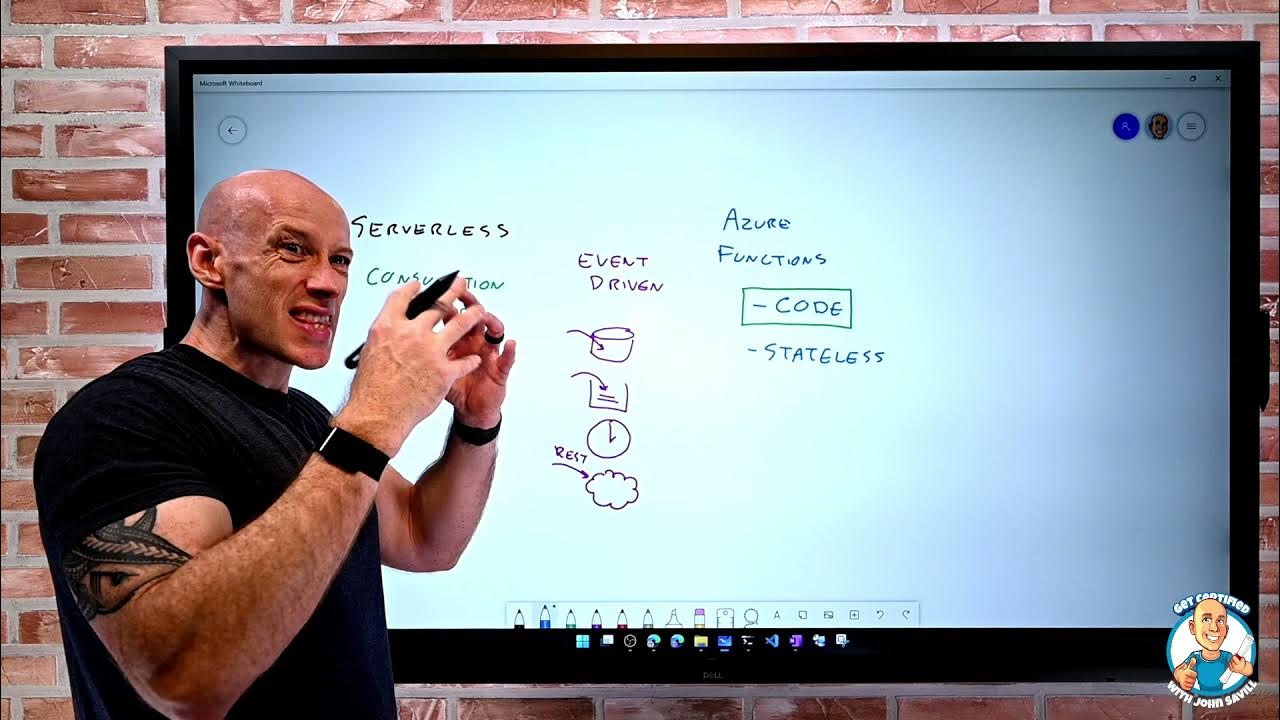Azure Function Apps Tutorial | Introduction for serverless programming
Summary
TLDRThe script provides an introduction to Azure Function Apps, a service for running event-driven serverless code without managing infrastructure. It outlines key features like flexible development, multiple languages and runtimes, easy integration with Azure services via bindings, and a consumption-based pricing model. A demo walks through creating a blob triggered function that processes files uploaded to blob storage, highlighting simplified functionality with only a few lines of code. The video conveys how Function Apps enable rapid development and deployment of scalable, cost-effective solutions.
Takeaways
- 😊 Functions are small pieces of reusable code that can be triggered by events
- 👍 Function pricing is cheap - first 400,000 GB-s and 1M executions are free
- 🔥 Bindings make connecting functions to other Azure services simple
- 📝 Many languages are supported including C#, Java, JavaScript, PowerShell & Python
- 🚀 Quickly create functions in the Azure portal for testing before deploying from VS Code
- 🔗 Triggers start function execution and outputs enable writing results to services
- 📦 Bindings support Azure services like Blob Storage, Event Hubs, Cosmos DB etc.
- ⚙️ The host.json file controls low-level settings like routes, concurrency limits etc.
- 🛠 Use App Settings to manage environment configurations and connections strings
- 🎉 Functions scale automatically without managing servers, so no infra overhead!
Q & A
What are Azure Functions and what are they used for?
-Azure Functions are a service for running small pieces of code without having to manage servers or infrastructure. They allow you to focus just on your code while Azure handles scaling and management behind the scenes. Functions are commonly used for data processing, integration, scheduled tasks, and more.
What languages and frameworks can you use to write Azure Functions?
-You can write Azure Functions in C#, Java, JavaScript, PowerShell, Python, and more. On the .NET side, you can use both the .NET Framework and .NET Core.
How are Azure Functions triggered?
-Azure Functions need to be triggered in order to execute. Triggers could include HTTP requests, changes in database data, queue messages, file uploads, scheduled timers, and more. A function can only have one trigger but may also bind to multiple inputs and outputs.
How are Azure Functions priced and scaled?
-By default Azure Functions run on a consumption plan, which means you only pay for the resources used while your functions run. There is a free grant for the first 400,000 GBs processed and 1 million executions per month. Beyond that, pricing is very low cost per million executions and gigabytes processed.
Where can Azure Functions code and configuration be edited?
-In the Azure portal, you can edit Function code and configuration directly. For more robust development, Azure Functions can be developed locally using Visual Studio Code and deployed to Azure. Configuration like bindings can be set both declaratively in code as well as visually in the Azure portal.
How does simplified integration work with Azure Functions?
-Binding to inputs and outputs is very simple with Azure Functions. For example, you can bind to blob storage and automatically trigger when a new file is uploaded or bind to a database and query data within your function. These bindings require just a simple declarative configuration.
What is the purpose of the host.json file?
-The host.json file controls settings for how the Azure Functions runtime should behave, including things like HTTP routes, concurrency limits, timeouts, and more. This allows control over the environment without having to manage VMs or infrastructure.
Can Azure Functions integrate with other Azure services?
-Yes, Azure Functions have out-of-the-box integration with several Azure services via bindings, including Storage, Cosmos DB, Event Grid, and many more. This allows using other Azure services directly in your serverless functions.
What options exist for testing and monitoring Azure Functions?
-The Azure portal provides built-in testing capabilities for Functions. Additional monitoring is available by integrating Application Insights, which will provide telemetry data on function executions. Functions can also be tested locally before deploying to Azure.
How are connections to other resources handled in Azure Functions?
-Connections to linked resources like storage accounts are configured through application settings that are automatically supplied to the functions when running. For local development, these connections can leverage the local emulator.
Outlines

このセクションは有料ユーザー限定です。 アクセスするには、アップグレードをお願いします。
今すぐアップグレードMindmap

このセクションは有料ユーザー限定です。 アクセスするには、アップグレードをお願いします。
今すぐアップグレードKeywords

このセクションは有料ユーザー限定です。 アクセスするには、アップグレードをお願いします。
今すぐアップグレードHighlights

このセクションは有料ユーザー限定です。 アクセスするには、アップグレードをお願いします。
今すぐアップグレードTranscripts

このセクションは有料ユーザー限定です。 アクセスするには、アップグレードをお願いします。
今すぐアップグレード5.0 / 5 (0 votes)






